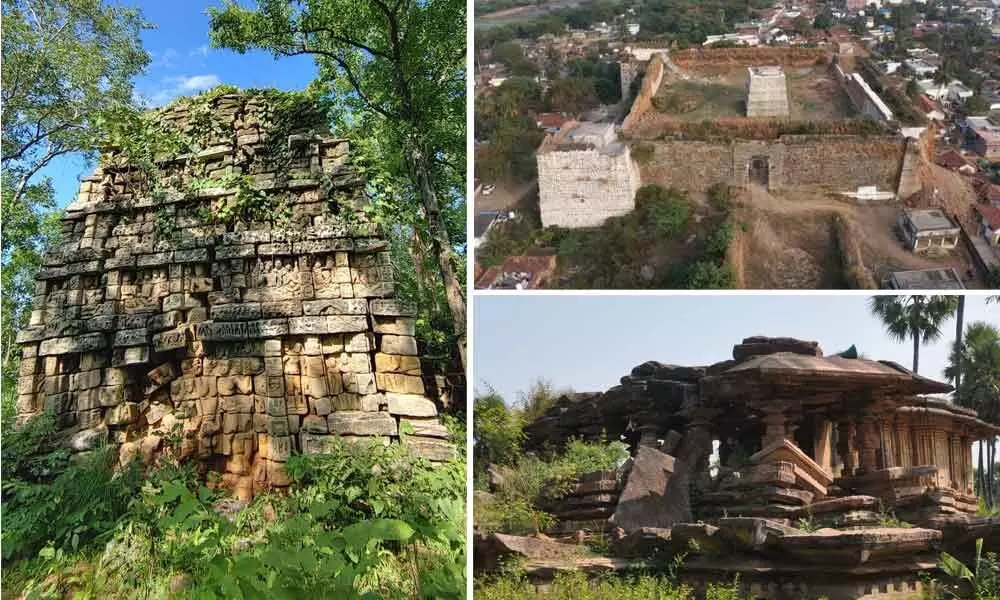Warangal: Monumental neglect of heritage

A sculpture in Devuni Gutta in Mulugu district(Left); Aerial view of Khilashapur Fort in Jangaon district(Right Top); Reddy Gudi in Jayashankar-Bhupalpally district(Right Bottom)
Warangal has an exceptionally rich heritage of ruined monuments and they continue to languish further due to indifferent attitude of the government agencies concerned.
Warangal has an exceptionally rich heritage of ruined monuments and they continue to languish further due to indifferent attitude of the government agencies concerned.
There is an imminent danger of losing several historical structures such as 'Devuni Gutta', 'Reddigudi, Khilashapur Fort' and others once for all unless permanent measures were taken on a war footing. Adding more to the red tape, the abundancy of rains in the last few seasons were threatening to pull down the heritage structures.
A peep into some of the majestic structures that are perilously close to vanish. The sandstone sculptures of 'Devuni Gutta' temple in the thickets near Kothur village in Mulugu district, 210 kms northeast of Hyderabad, came to light in 2017. Prior to that, it was only a venue for the Adivasis' yearly ritual.
'Devuni Gutta' is indeed in danger of disappearing into oblivion even before the world could notice that an Angkor Wat-like temple, Cambodia's pride, is hidden in the dense forests of Mulugu district.
The architecture of the temple gives an impression that it refers to the times of Vishnukundina, the imperial that controlled Deccan, Odisha and parts of southern India during the 5th and 6th centuries. The sculptural elegance of the temple corresponds to that of Udayagiri and Scandagiri of Odisha, and Amaravati in Andhra Pradesh.
The travesty is such that the temple which was drawing quite a few architecture and history researchers - Prof Adam Hardy, Architectural historian at the Welsh School of Architecture, Cardiff University, and Dr Corinna Wessels-Mevissen, a German expert in iconology of Indian sculptures and mediaeval temple architecture - from abroad had failed to draw the attention of the Archaeology and Museums Department despite repeated requests from the locals.
Historian Aravind Arya Pakide who had written many letters to the authorities told The Hans India, "Since we explored the temple in 2017, not a single step was taken to protect the temple. A marvel in the woods is ready to collapse with the rainwater taking its toll on the lime mortar filled in the gaps of sandstone blocks."
On the other hand, the 17th century Khilashapur Fort built by Sardar SarvaiPapanna is not far away from being reduced to rubble. The fort, built by dung sunnam (lime mortar mix), has five buruzus (fortified towers) with its ramparts convenient to fire cannons.
The State Archaeological Department took up the conservation of the iconic fort in 2018 with an estimated cost of Rs 4.5 crore. Although the State Government had promised to develop it as a tourist place, the work on restoration has been moving at a snail's pace. In October 2020, one of the fortification walls collapsed due to heavy rains.
With breaches again to fore in the fort early this month, Tourism Minister V Srinivas Goud assured the locals of developing the fort.
Elsewhere at Ghanapuram village in Jayashankar-Bhupalpally district, 200 kms northeast of Hyderabad, Kota Gullu, a cluster of 22 temples built in the first 13th century languishing in a state of absolute neglect.
The State Archaeological Department which disassembled nine of the 22 temples for the purpose of reconstruction a few years ago didn't return to make it happen. With the rainwater starting to seep in and falling on the sanctum sanctorum, the temple Committee has been taking temporary measures every year by covering the roof with polythene sheet.
A few paces away from Ganapeshwaralayam, the Shiva temple, known as Reddy Gudi, believed to have been constructed by Ganapathi Reddy, a member of Recharla family, is also ready to cave in. The temple, facing north consists of garbhagriha, antarala and entrance ways on north, east and western sides, has a unique sculptural elegance.

















